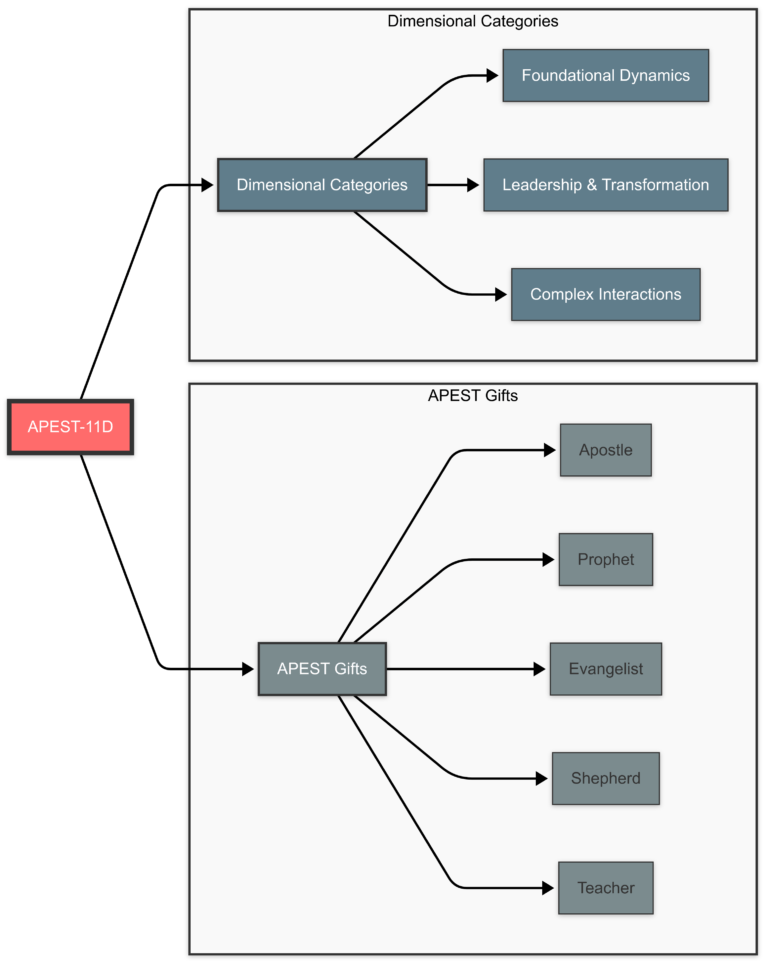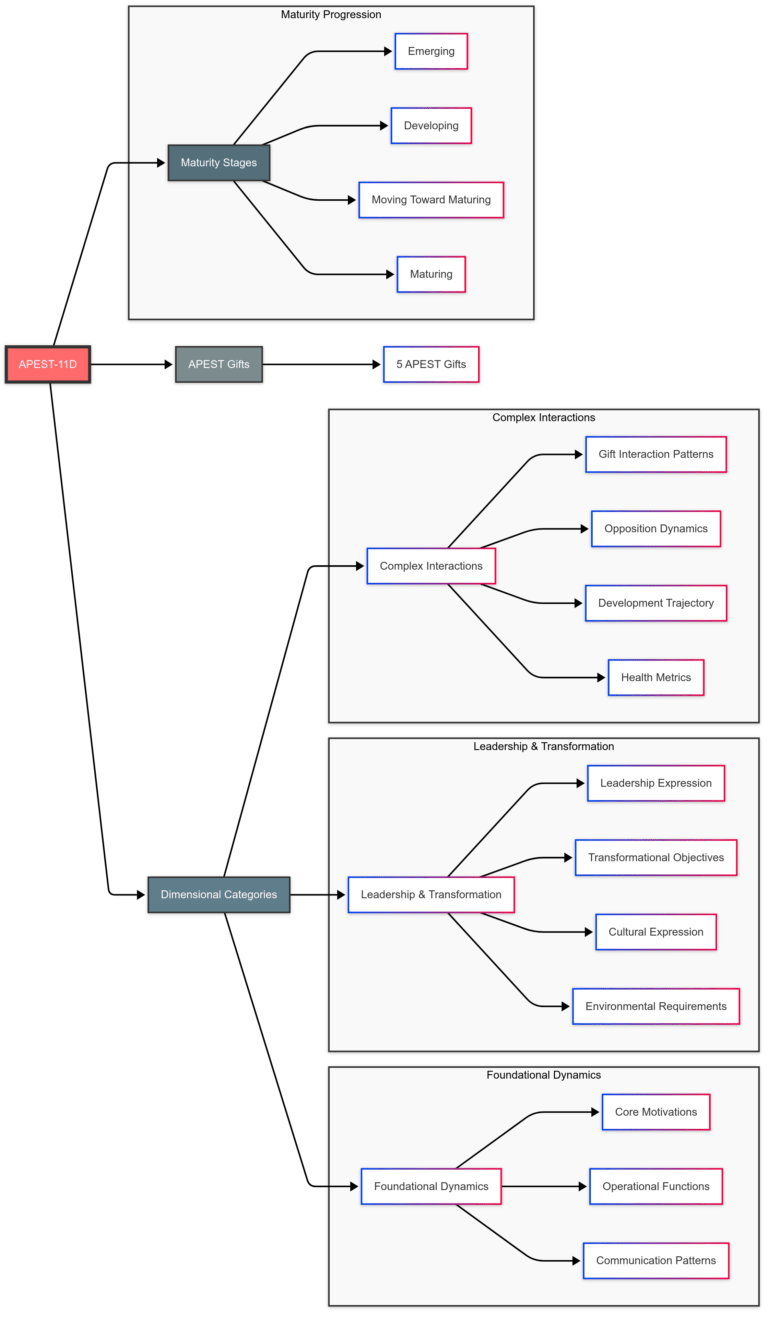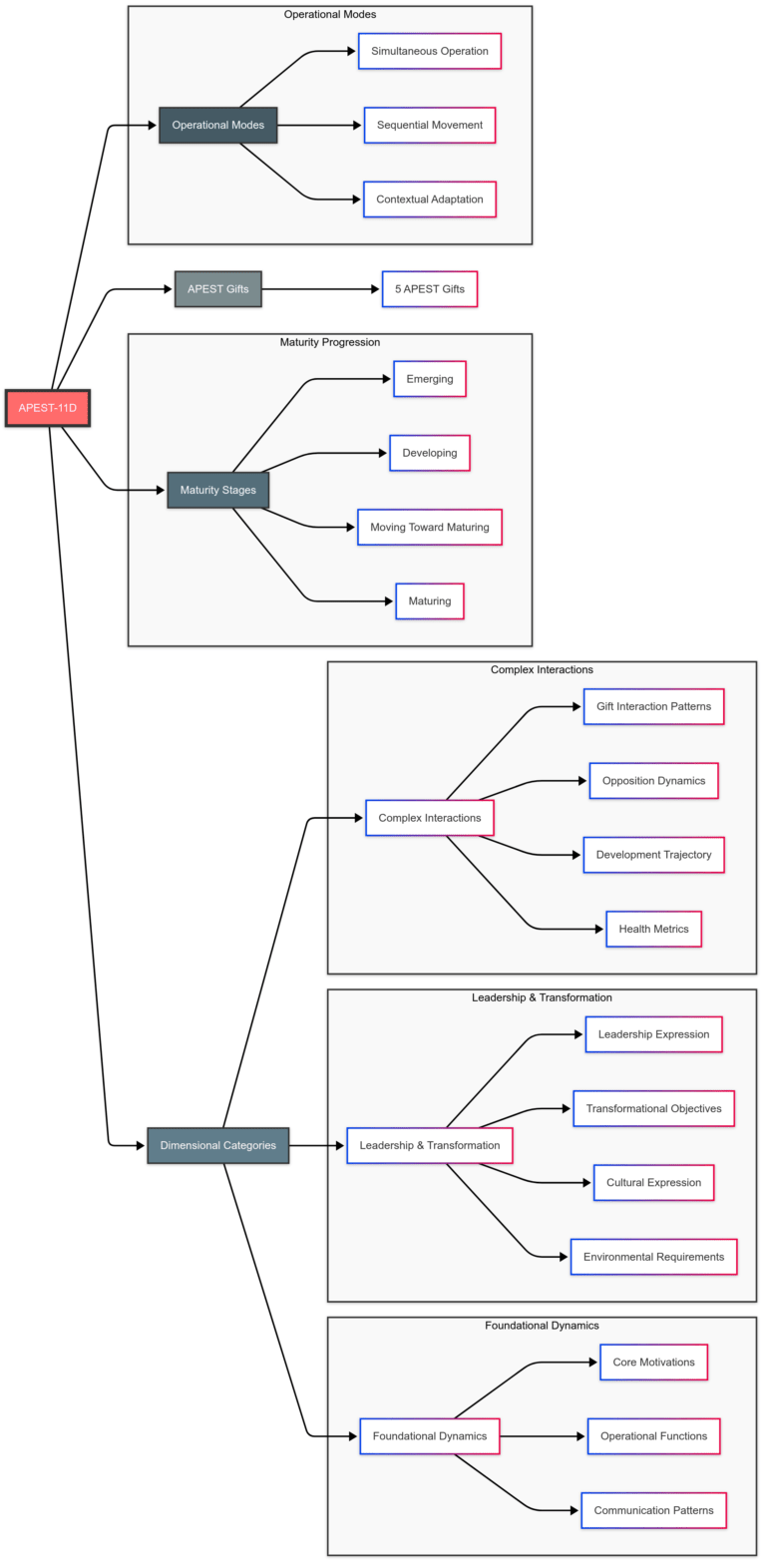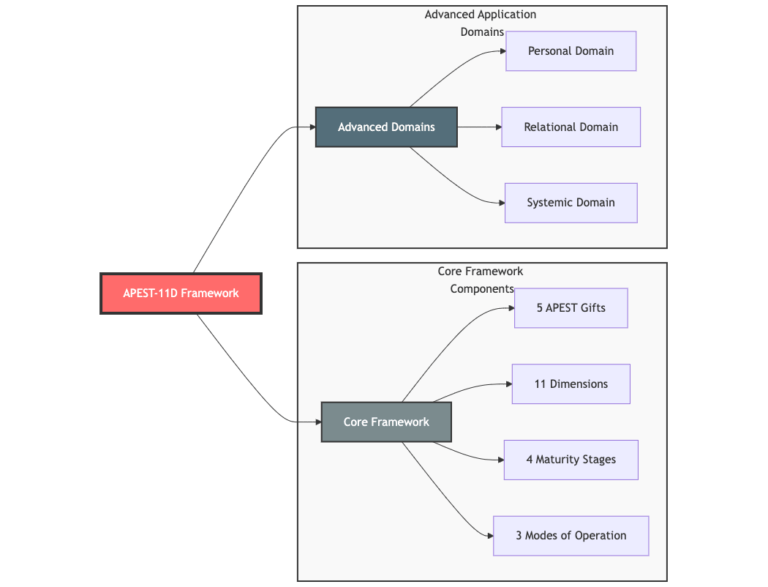APEST Team Dynamics: An Overview
This abstract examines the impact of contextual gift dynamics on APEST ministry team effectiveness and argues that many leadership departures are misinterpreted as spiritual transitions rather than systemic failures in gift alignment. While churches and organizations often assess success through conventional metrics such as attendance, budgets, and programs, these measures fail to capture the qualitative outcomes emphasized in Ephesians 4—unity, maturity, stability, and holistic growth into Christ. This misalignment creates structural ceilings that hinder leaders from thoroughly engaging, ultimately weakening the church’s capacity to function as the body of Christ.
Drawing from scriptural analysis and leadership case studies, this study explores the theological and organizational consequences of failing to recognize contextual expressions of APEST gifts. It further introduces the APEST Operating System™, a framework designed to diagnose and correct these misalignments through three core components:
- APEST-11D™ – Mapping how gifts function across eleven dimensions of ministry.
- APEST Polarities™ – Transforming conflicts into productive tensions.
- Experiential Fingerprint™ – Capturing the development and present expression of APEST gifts.
This framework offers a corrective model for church leadership by revealing underlying patterns in gift operation, such as leaders engaging multiple gifts simultaneously, sequential gift expressions, and context-dependent manifestations. Ultimately, this paper argues that churches built without honoring the full contextual expression of APEST gifts may appear outwardly successful while remaining misaligned with God’s architectural intent.
When APEST gifts function correctly, they facilitate ministry activity and reveal Christ to the world through unity, maturity, and love-driven mission—hallmarks of a church truly aligned with God’s design. While the APEST Operating System™ comprises multiple components, this paper focuses explicitly on APEST-11D™, outlining its function and significance in accurately mapping and understanding gift dynamics in ministry.
The Contextual Gift Dynamics Gap: APEST Team Challenges We're Solving
Identifying Fivefold Ministry gifts has been shaped by static assessments that provide a helpful starting point; however, ministry is not static. Leaders don’t just operate within fixed gift categories; they adapt, shift, and engage in dynamic, real-world contexts. The problem? Standard APEST assessments were never designed to capture these real-world gift interactions, leaving a significant gap in how we understand and develop APEST ministry teams.
The Contextual Gift Dynamics Gap highlights how gifts function differently across ministry contexts (contextual) and interact in complex, real-time ways (dynamic). This isn’t just theory; it’s the lived reality of leadership. Whether we measure it or not, these interactions shape daily leadership dynamics, decision-making, and the long-term effectiveness of teams.
Addressing this gap has led to discovering five critical problems—not just with APEST assessments but with how we fundamentally understand the function of Christ’s gifts in ministry contexts. These challenges exist not because standard approaches are flawed but because they were never designed to capture these deeper realities of the Contextual Gift Dynamics Gap.
These limitations have led to five significant challenges in APEST ministry and assessments
- The Gift-Expression Gap: Leaders Are More Than Their “Primary Gift”:
- Standard APEST assessments identify primary and secondary gifts but do not capture how leaders express multiple gifts across different ministry settings. This creates a necessary but rigid categorization that limits how leaders understand their actual contextual gift dynamics
- The result? Many leaders feel boxed into their primary gift label, struggling to validate or explain their natural use of other gifts in different contexts.
- APEST-11D™ Solution: By mapping gift expression across eleven dimensions, leaders gain a fuller, more accurate picture of how their gifts actually function.
- The Linear Development Myth: Gifts Don’t Mature in Isolation:
- Traditional models assume leaders develop and function in their primary gift before engaging others. In reality, mature ministry leaders operate in multiple gifts simultaneously, often in fluid and unexpected ways.
- The result? Leadership development programs focus too narrowly on primary and secondary single-gift mastery, missing the dynamic interplay of gifts that actually defines effective leadership.
- APEST-11D™ Solution: By revealing how the third-ranking gift acts as The Bridge Gift™, unlocking both the highest and lowest-ranking gifts, APEST-11D™ provides a more accurate model of gift progression.
The Five Team-Tension And Challenges Continued
3. The Team-Tension Challenge: Friction Isn’t a Problem, it’s the Initiation Process into Effective Teams:
- Leadership teams often view gift-expression tension as a problem, rather than an essential dynamic. This tension is not a roadblock, but an initiatory experience that elevates each gift’s function and team understanding. Without the initiatory process, teams do not mature.
- The result? Two common but limiting patterns emerge: (1) teams fracture along gift lines, missing the synergy of different strengths, or (2) dominant gifts overshadow others, limiting full ministry expression.
- APEST-11D™ Solution: Rather than compromising between gifts, teams must learn to leverage the tension by Integrating and Balancing APEST Polarities™, a method that unlocks the Unified APEST Mission™.
4. The Contextual-Primary Paradox: Why a Third-Fourth- or Fifth-Ranked Gift Sometimes Becomes Primary:
- APEST assessments provide a static ranking of gifts, but they don’t account for how a “weaker” gift can suddenly become dominant in specific contexts or relational settings.
- The result? Leaders are often surprised (or confused) when they operate most effectively through what appears to be a lesser-ranked gift in certain situations.
- APEST-11D™ Solution: By introducing Complex Interactions™ to track when and why gifts shift based on context, APEST-11D™ explains why these patterns emerge and how leaders can harness them.
5. The Gift-Perception Trap: How Assessment Results Create Artificial Limitations:
- Without contextual understanding, APEST equipping and assessment results create internal and external psychological and social barriers to gift expression.
- The result? Internally, leaders define their ministry identity around their top gifts (“As a prophet, I focus on truth-telling, not nurturing”), limiting their willingness to operate in other expressions. Externally, teams develop rigid expectations (“Let’s not ask Sarah about community care since she’s an apostle”), creating social barriers that restrict contribution. Together, these perceptions create artificial ceilings that prevent personal development and team effectiveness.
- APEST-11D™ Solution: By mapping gift function across three Dimension Categories™ and three Operational Modes™, APEST-11D™ provides a framework that liberates leaders from restrictive identity limitations and enables teams to recognize each member’s contextual gift expressions.
Benefits of Understanding Contextual APEST Dynamics:
By capturing the dynamic-contextual nature of Fivefold gifts, APEST-11D™ provides the missing structure that experienced leaders have always known intuitively: gifts don’t operate in isolation, and they don’t function the same way in every setting. This framework isn’t just a theoretical improvement—it’s a practical shift in how leaders understand their own gift expression, how teams collaborate, and how the church fulfills its mission. APEST-11D™ doesn’t just measure gifts. It reveals the contextual and dynamic patterns that shape ministry itself.
Component I: APEST-11D™ Basics, Integrating the Fivefold Ministry Gifts:
In APEST-11D™, the five APEST gifts are understood as interconnected expressions that develop within various contexts. We recognize that individuals operate multiple gifts with varying expressions over time. Therefore, identifying one’s primary or secondary APEST gifts provides a foundation for growth. The APEST-11D™ descriptions of healthy expressions of the Five APEST Gifts are simplified to emphasize the developmental elements of APEST-11D™ in subsequent sections.
- Apostle: A messenger, ‘sent one,’ commissioned with authority to establish and oversee foundational work, often in new geographical or conceptual territories.
- Prophet: One who “speaks forth” the heart and mind of God, revealing truth, exposing falsehood, and calling people to greater faithfulness and alignment with God’s purposes.
- Evangelist: A liberator who uses compelling communication to connect, convict, and inspire others, proclaiming the liberating message of Jesus Christ.
- Shepherd: A nurturer who protects, cares for, and guides others toward greener pastures of spiritual and personal development.
- Teacher: An instructor who points things out for clarity, fosters understanding, and provides correction for growth.
- Apostle: A messenger, ‘sent one,’ commissioned with authority to establish and oversee foundational work, often in new geographical or conceptual territories.

Component II: The Three Dimensional Categories™
While the Five APEST Gifts form the foundation, APEST-11D™ further refines our understanding by introducing eleven dimensions that reveal the complexity of how these gifts are expressed. These dimensions are categorized into three overarching groups:
Foundational Dynamics Dimensions The Foundational Dynamics dimension represents the core elements of individual functioning, a foundation for personal and leadership identity.
Leadership & Transformation dimensions: The Leadership and Transformation dimension focuses on how individuals express leadership, influence change, and align with transformational objectives within their ministry and professional environments.
Complex Interactions Dimension: The Complex Interactions Dimension highlights the intricate ways individuals navigate challenges, interact with others, and develop over time.

Component III: The Eleven Dimensions Of Human Interaction™
Now that we’ve introduced the three category groupings, we can explore their eleven dimensions. These dimensions provide a deeper understanding of how APEST gifts function, from foundational expressions to complex ministry dynamics.
Category 1: Foundational Dynamics Dimensions:
These dimensions define the core elements that shape an individual’s identity, motivations, and interactions.
- Core Motivational Drivers: Intrinsic forces that propel individual actions and decision-making processes within the APEST gift mix.
- Operational Functions: The practical methods and daily processes an individual employs to execute tasks effectively.
- Communication Patterns: The verbal and non-verbal ways an individual conveys ideas, collaborates, and engages with others.
Category 2: Leadership & Transformation Dimensions:
These dimensions focus on how individuals express leadership, drive transformation, and align their gifts with broader goals.
4. Leadership Expression: How an individual manifests leadership to others through their Fivefold Ministry calling.
5. Transformational Objectives: The vision and goals an individual pursues to drive meaningful change.
6. Cultural Expression: How an individual interacts with and shapes the cultural landscape within their organization or community.
7. Environmental Requirements: The ideal conditions, structures, and resources necessary for an individual to thrive in their APEST role.
Category 3: Complex Interactions Dimensions:
These dimensions explore the dynamic ways individuals navigate relationships, challenges, and long-term growth.
8. Gift Interaction Patterns: The interplay between an individual’s APEST gifts and the gifts of others, shaping collaborative dynamics.
9. Opposition Dynamics: How an individual responds to resistance, conflict, and adversity in leadership and ministry settings.
10. Development Trajectory: The growth path influenced by personal experiences, learning, and refinement of the Fivefold Ministry gifts.
11. Health Metrics: Key indicators of an individual’s overall well-being, balance, and sustainability within their leadership role.

Component IV: Maturity Stages™
APEST-11D™ framework identifies four stages of maturity in developing APEST gifts and dimensions.
Emerging: Initial recognition and exploration of primary and secondary gifts across dimensions.
Developing: Intentional growth and practice in utilizing two to three gifts across dimensions.
Moving toward Maturing: Increasing proficiency and integrating three to four gifts across various dimensions.
Maturing: Advanced integration and nuanced understanding of three to five gifts across various dimensions.
These stages represent a continuous growth process, recognizing that individuals evolve in understanding and applying gifts. Since gifts mature dynamically, there is no need for five separate maturity levels, one for each APEST gift. Instead, these four stages sufficiently capture the progression of growth.

Component V: Operational Modes™
The APEST-11D™ introduces three operational modes that provide a comprehensive understanding of how individuals express and utilize their APEST gifts in the real-world context:
- Simultaneous Operation Across APEST Gifts: This mode demonstrates how individuals utilize multiple aspects of their APEST gifts concurrently, revealing a dynamic and multifaceted approach to leadership and ministry that might otherwise go undetected.
- Sequential Movement Through Options: This mode acknowledges that effective leaders sometimes progress through different gift expressions step-by-step, implementing one gift at a time in response to specific situations or developmental needs.
- Contextual Adaptation of Gift Expression: This mode emphasizes the flexibility to adjust gift expression based on specific situations or environments, a crucial skill observed in successful APEST leaders.
- Simultaneous Operation Across APEST Gifts: This mode demonstrates how individuals utilize multiple aspects of their APEST gifts concurrently, revealing a dynamic and multifaceted approach to leadership and ministry that might otherwise go undetected.
These operational modes are not just theoretical models—they are derived from real-world observations of how successful leaders navigate complex ministry environments. By bridging the gap between theory and practice, these modes provide a framework for understanding the dynamic nature of APEST leadership in diverse contexts.

Conclusion: Our Contribution to the Fivefold Ministry Development
We’ve all seen it happen: Leaders excitedly discover APEST gifts, grab the blueprint, and start building—without fully understanding how to read the architectural plan. In our enthusiasm to implement what we recognize as God’s design, we’ve often missed critical dimensions of how these gifts actually function.
But here’s the challenge: When APEST is applied without this nuance, leaders don’t just struggle—they retreat. Many who initially embraced APEST have now become inoculated against it, concluding that, as my colleague Tim Cathems insightfully put it, APEST often ‘overpromises and underdelivers’ when key dimensions and equipping are missing. Our conversations highlighted how many leaders, after initial excitement, now dismiss APEST as another passing framework instead of pressing deeper.
APEST-11D™ doesn’t just provide better measurement; it restores confidence in APEST itself by revealing the complete picture. Mapping gifts across Eleven Dimensions of Human Interaction™, Maturity Stages™, and Operational Modes™, it uncovers what eager implementation has obscured: Christ’s gifts operate in dynamic, adaptive patterns that shift across contexts that require equipping.
The question isn’t whether we value APEST gifts; clearly, we do. The question is whether we’ll slow down long enough to understand how they actually function before continuing to build. Will we recognize that our enthusiasm has outpaced our understanding? Ministries, organizations, and individuals are navigating increasing complexity, and without deeper insight, APEST risks being abandoned by those who once championed it.
APEST-11D™ advances the movement beyond static categorizations, recognizing that individuals engage with their gifts in diverse, adaptive ways throughout their personal and professional journeys. As a core component of the broader APEST Operating System™, it equips leaders not just with enthusiasm but with understanding—ensuring long-term impact, leadership effectiveness, and team collaboration.
With this foundation established, the next step is to explore how APEST-11D™ is measured. Part 2 introduces the scoring logic, detailing how the Eleven Dimensions, Maturity Stages, and Operational Modes are assessed—providing a meaningful, actionable profile of an individual’s unique gift expression.
To conclude, I’d like to share a quote from pioneer and author Mr. Alan Hirsch: “It is only when the people of God as a whole are activated in a movement that real-world transformation takes place.”
Frequently Asked Questions
What is the 'Contextual Gift Dynamics Gap,' and why is it important?
The Contextual Gift Dynamics Gap highlights how APEST gifts function differently across various ministry contexts and interact dynamically in real-world leadership. Understanding this gap helps leaders avoid misalignment and maximize their gifts effectively.
How does APEST-11D™ differ from traditional APEST assessments?
APEST-11D™ goes beyond static assessments by mapping gift expression across eleven dimensions, capturing the dynamic and contextual nature of leadership in ministry.
How can APEST Polarities™ improve team dynamics?
APEST Polarities™ help teams navigate natural tensions between different gifts, transforming conflicts into productive interactions that enhance team synergy and mission effectiveness.
What are the benefits of understanding the 11 dimensions of human interaction in APEST?
Recognizing the 11 dimensions allows leaders to develop a holistic view of their gift expressions, improve collaboration, and align their teams with God’s design for ministry effectiveness.








